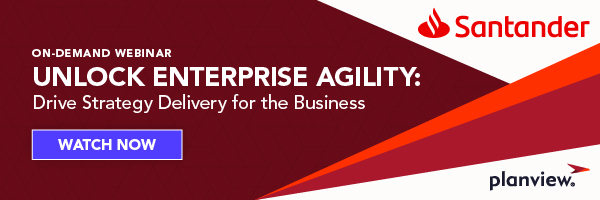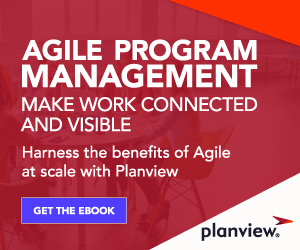
The big question around the efficacy of Agile transformation inevitably turns to Agile ROI: Can Agile really improve productivity, decrease risks and costs, and increase revenue?
In a recent webinar titled “The ROI of Agile Scaling and Transformation,” Ronnie Pinkerton, Director of Solution Architecture and Steve Wolfe, Enterprise Agile Coach & Evangelist at Planview, explored several industry trends that help to unpack this heavily loaded question and discussed how you can justify your Agile investment with the Planview Enterprise Agile Planning solution.
This blog features the statistics and notable highlights from the webinar for you to consider as your organization advances its own Agile transformation.
But first, a quick disclaimer: By simply undergoing an Agile transformation, a business is not guaranteed to produce the same results shown in each of the statistics we shared. As you transform, there are certain considerations involving people, process, and technology that can help you start to realize these results. But only with practice and discipline are they truly achievable.
Increase Productivity
“Agile transformation can reduce time to market by at least 40 percent.”
McKinsey & Company
Reducing time to market is about enabling organizations to deliver value to customers faster. This involves increasing visibility, defining objectives, and aligning teams to those objectives.
But there’s more to the story.
According to Wolfe, it is important to:
- Establish high-performing Agile teams throughout an organization
- Provide clarity on priorities, and
- Align work to those priorities
This is what Agile Program Management is all about. And, within it, are mechanisms to support teams of teams from planning to delivery.
But, in addition to visualizing, planning, and coordinating work, the ability to focus is key. In the truest sense – less is more. It’s better to focus on fewer items that we know are the most important to the business, in order for teams to complete their most important work faster and help the company realize value sooner. Additionally, doing the right things can speed time to market.
The right technology will enable organizations to:
- Understand the flow of value throughout the system and the pace at which work moves through the system
- See how work is planned, prioritized, and delivered
- Spot unhealthy patterns such as increasing scope without making necessary tradeoffs
It’s hard to realize true productivity increases until teams mature together.

Decrease Risks
“…Agile projects enjoy a 60% greater chance of success than non-Agile projects. Looking deeper, we find that ‘waterfall’ projects are three times more likely to fail than Agile projects.”
The Standish Group
Ensuring the success of projects, initiatives, and the like, is all about the reduction of risk. By visualizing priorities, capacity allocations, and dependencies between work items and aligning teams to strategic priorities, businesses can reduce the likelihood of falling short of their goals.
Focus
According to Wolfe, risk takes on many forms in an Agile program, and it really starts with: Are we doing the right work? Can we see the priorities clearly? Can we also see what hasn’t been committed to and is in the backlog? A big risk that teams fall victim to is taking on additional work items that aren’t high priority. What’s worse is doing so without even having a means of seeing when this happens.
Additionally, teams need to manage their capacity and build a plan that considers their true bandwidth across the planning horizon. What’s more, teams must evaluate their capacity day to day, to manage WIP and not spread themselves too thin. Focus makes a big difference in reducing risk: Making a conscious tradeoff to say “not yet” to certain work, in order to finish high-priority work first.
Visibility
Then there are things like coordinating dependencies and addressing blockers immediately. In a larger sense, you’ll always have things at the program, or meta-level, that are related to the work that ultimately must be resolved before work can move forward.
It really comes down to visibility. To support this, and to help reduce risk to a successful degree, two things need to be achieved:
- Teams need to ruthlessly plan and prioritize their work, with a continuous understanding of capacity.
- Leadership needs to take responsibility for their own backlog management.
It’s also important to be able to pivot away from the work if the risk is too great or it’s not producing the desired results. An Enterprise Agile Planning solution is really the ticket to that visibility necessary for proper risk management.
The right technology will enable organization to:
- Understand where risks exist within plans
- Elevate a discussion around those risks and take ownership of risk at the team or leadership level to manage it appropriately
- Get a feel for the health of the entire system and understand trends over time
Adopting and implementing the right technology or software can help you realize the aim of reducing risk and, in turn, help you improve the likelihood of success.
Decrease Costs
“Agile projects and programs cost 3.6x less than traditional waterfall projects and programs involving similar functionality.”
– The Standish Group
Cost reduction is not always the key objective of an Agile transformation. But it’s a natural effect because transformations prompt improvements to operational performance. This is achieved by aligning projects with available resource capacity, assigning the right skills to the right projects, and by gaining visibility into project performance – all of which has a direct impact on a company’s bottom line and can serve to help maximize Agile ROI.
The right technology will enable organizations to:
- Evaluate the financial impacts of certain decisions through what-if scenarios
- Select the right initiatives to fund to achieve the best financial outcome

Increase Revenue
“…75% of organizations with high agility report a minimum of 5% year-over-year revenue growth… compared to only 29% of organizations with low agility.”
Project Management Institute
How can agility help increase revenue for a business and truly achieve the desired Agile ROI? It can be done by helping teams keep costs low, prioritize the right work, and stop work when it is appropriate.
Agility is all about thinking strategically and connecting your plans to the teams executing the work – those helping to deliver value to the customers. But it also involves the ability to adapt to changes in the market or based on evolving customer needs.
When guided by company leadership, this involves thinking through the following questions:
- What strategic outcomes do we need to achieve, including objectives and key results (OKRs)?
- Beyond driving for outcomes, what other company initiatives do we need to deliver to move the business forward?
- What KPIs are we driving toward?
- How will we know we’ve achieved our goals?
Market changes happen very quickly. The right technology or software solution can help to ensure that all parts of the organization are planning and delivering effectively. It can help ensure that the work that is being planned is tied back to strategic company goals and that the work is tightly coordinated across teams at all levels of the organization.
The right technology will enable organizations to:
- Stay laser focused on their mission and objectives
- Evaluate the impact of changes to strategy and form the best plans to reach their financial goals
- Gather real insights from the teams and how their work is progressing to ensure success
Bringing it all Together
As you move through your Agile transformation, understand it is a journey and that people, process, and technology all play a vital role. I invite you to watch the on-demand webinar and listen to the discussion to learn more. For a deeper dive into the technology we showcased in this session, check out the Planview Enterprise Agile Planning demo.

![451 Research Perspectives on Agile Program Management [Video]](https://blog.planview.com/wp-content/uploads/2020/11/451-Video.gif)
![Agile Program Management: How to Increase Agile Scaling Success [Video]](https://blog.planview.com/wp-content/uploads/2020/09/Apm-video.gif)

